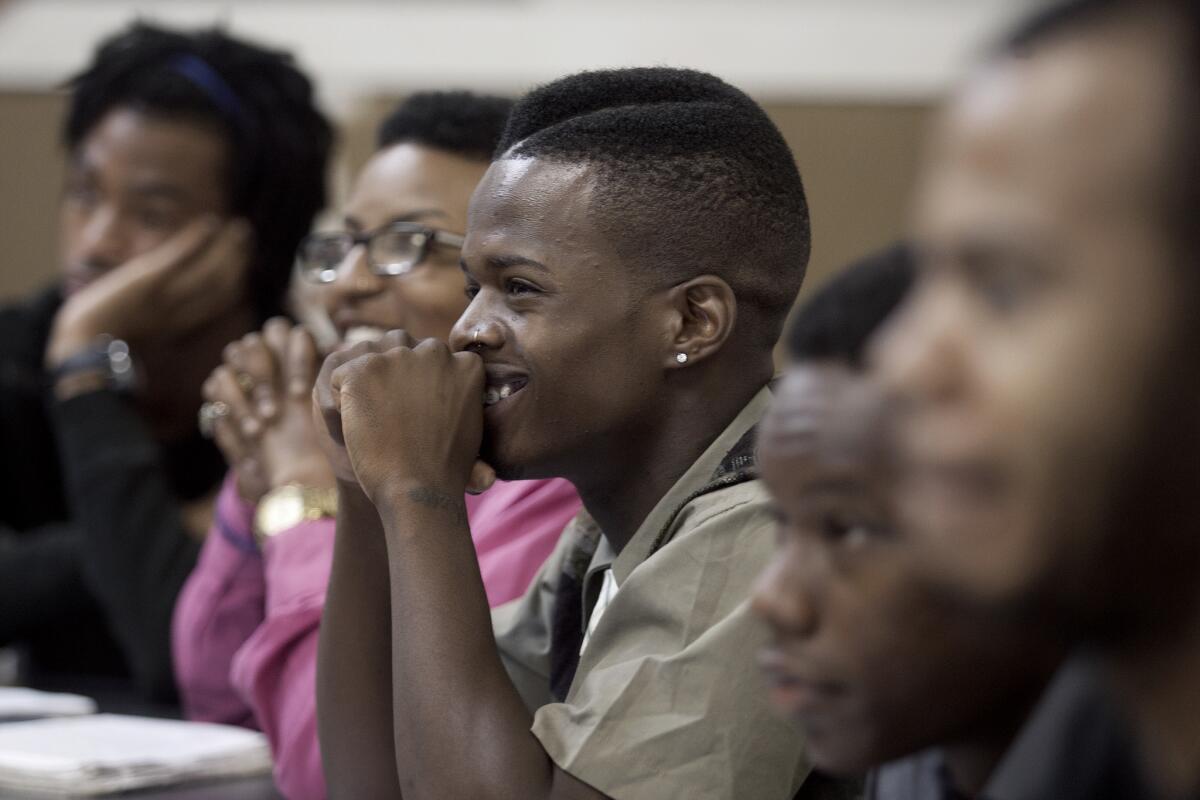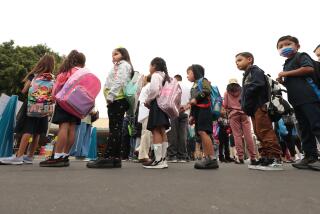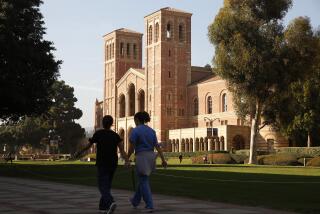Here’s what’s holding black students back, from preschool through college

Marcus Davis, 21, and other high school graduates and seniors attend a College Bridge class in 2014.
One in five black high school students in California drop out before they can graduate. That’s the highest dropout rate of any race or ethnicity in the state, and much higher than the state’s overall 12% dropout rate.
And when black students get to college in California, they are also the least likely to graduate from state community colleges, Cal State universities, or UC’s.
Why is this happening? Why do black students fare worse in today’s education system than every other group? These are questions that researchers, parents, educators have been tackling for decades, if not longer.
The Times’ new education initiative to inform parents, educators and students across California >>
Nationally, many factors play a role: Housing discrimination reinforces school segregation; there aren’t enough black teachers; school administrators and public employees treat black students differently — video surfaced Monday of a white school resource officer in South Carolina slamming a student who appears to be black to to the ground, then dragging her across the floor.
A new report from the nonprofit education advocacy group Education Trust - West, to be released Wednesday, tries to answer those questions for California students. The authors pulled together existing data to show that at every benchmark in black students’ lives, from preschool through college, they face greater challenges than many of their peers. The report, called “Black Minds Matter,” also includes examples of districts in the state that are addressing these issues with tangible results.
California is different from most states in that it serves many students of color, but most are Latino. Black K-12 public school students are large in numbers — about 373,000 — but that’s only 6% of the state’s public school population. A third of those students are in Los Angeles County.
The challenges for black students start at a young age. Take enrollment in preschool or kindergarten for children ages 3-5. Enrollment for black students is the same as the statewide rate — 60% — but that’s largely because Latino students have a lower preschool and kindergarten enrollment, and account for the majority of students. White and Asian students have better representation than black and Latino students.
Early education is extremely hard to measure, because most public school systems start in kindergarten, so there is little regulation or definition of what counts as preschool or prekindergarten. This report uses Census data.
California is trying to improve access to prekindergarten and kindergarten classes by requiring districts to offer transitional kindergarten to students. A program in San Francisco that offers families free or reduced-price preschool for 4-year-olds has increased its enrollment of black and Latino students.
The black students who are enrolled also begin to face racism in the classroom that early, as a recent report from the California attorney general’s office points out.
That persists throughout students’ education. Teacher discrimination is well-documented, as the report notes: “One study found that teachers more quickly develop negative responses to student behavior when those students are black. Another found that teachers are more likely to suspend a student who conducts a minor offense like using a cell phone or violating the dress code if that student is black.”
“Structural racism is real, individual acts of racism are real,” said UCLA education professor Tyrone Howard. That’s a problem that the state’s educators need to face in order to create long-lasting improvement, he said.
Trauma is also an issue that affects student performance, and disproportionately that of black and Latino students, Howard said. Black students in seventh, ninth and 11th grades were more likely to feel unsafe at school, according to the report.
And while Brown vs. Board of Education was supposed to end segregation in schools decades ago, schools around the country are still highly segregated; California is no different.
Black students typically attend schools in which 69% of students are black, Latino or Native American. Compare that to a typical white student’s school, where 38% of students are black, Latino or Native American, and the rest are white or Asian — the two ethnicities with the most access to schools in middle- and upper-middle-class neighborhoods, that better prepare them for the CSU and UC system, as a 2014 UCLA study (where this data came from) notes.
Black students in California are also more likely to attend schools with a large low-income population.
Those schools have historically performed worse academically and have less access to high level classes for students, as the UCLA report notes.
And despite California’s local control funding formula that’s meant to allocate resources to low-income students and underserved communities, schools in poorer areas have fewer sources of additional funds from resources like parent funding, Harvard education doctoral candidate Eve Ewing said.
The Education Trust-West report highlights the Riverside Unified School District, which is trying to address the lack of African American students meeting Cal State University and UC requirements, called “A-G requirements,” by creating a mentorship program. Through the $250,000 annual program, called the Heritage Plan, school counselors and teachers identify black students in 10th through 12th grades who could fulfill those requirements, but aren’t on track, said Renee Hill, one of the district’s assistant superintendents.
See the most-read stories this hour >>
They notify the students and families of what needs to happen to meet those requirements and why it’s important, and offer mentorship and constant support through a teacher on each campus.
“They have another adult on campus that is not assigning them a grade that they can go to for support or direction,” said Callie Neal, the plan’s facilitator. The plan started in the 2013-14 school year. About 900 black students are in those grades, and more than 500 participate, she said.
In the 2010-11 school year, 25.8% of black graduates in Riverside Unified completed their A-G requirements. In the 2013-14 school year, that had risen to 33.2%. There’s still a ways to go before they meet the rest of the district’s rate of 41%.
Reach Sonali Kohli on Twitter @Sonali_Kohli or by email at sonali.kohli@latimes.com.
ALSO:
Families are choosing this L.A. school over privates and charters
Black LAPD officer sues city, says white officer wrongly followed and stopped him
FBI to investigate South Carolina deputy who threw student across classroom floor
More to Read
Start your day right
Sign up for Essential California for news, features and recommendations from the L.A. Times and beyond in your inbox six days a week.
You may occasionally receive promotional content from the Los Angeles Times.







